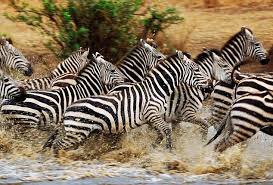Kenya Zebra’s Stripes Uncovered
The first time I was introduced to a Zebra in Kenya was by my artisan uncle. He showed me a wooden sculpture of a Zebra, beautifully painted with black and white stripes.
I handled and examined the wood carving as he described it. Later, as I was herding my father’s cattle during one of the school holidays, I saw the real Zebra and recognized it immediately. Yes, the black and white stripes are the trade mark of a Zebra. You will recognize it anytime, anywhere and at any age above three.
There are three species of a Zebra namely, Plains Zebra, Grevy’s Zebra and the Mountain Zebra. Africa is the home of all these species. While the Plain Zebra occurs in many parts of Kenya and parts of East Africa,Grevy’s Zebra is mainly found in Northern Kenya.The former outnumbers the other two zebra species. The Plains Zebra and Grev’s Zebra of Kenya have been known to coexist in the same habitat. The Mountain Zebra have their habitat in Southern and Southwestern Africa. Zebras are herbivorous and can grow up to 900 lb (410kg) or more. Being social animal, they move in herds of different sizes.
While the black and white stripe pattern makes the Zebra spectacular, the amazing facts about the stripes go beyond the beauty. For years scientists have argued about why the zebra has distinctive black and white stripes. The theories rotate around Zebra Identity and Camouflage. This article discusses these amazing theories:
– Description: Whether the Zebra’s stripes are white on a black background, as some people say, or vice versa is academic. I leave it at that.
– Identity: At first glance Zebras in a herd might all look alike, but their stripe patterns are as distinctive as fingerprints are in humans. There are, indeed, scientific methods that can identify individual Zebras by comparing patterns, stripe widths and color. Further proof that Zebra stripes are identity marks is provided by their behavior. For example, on rare occasions when unstriped Zebras are born, they tend to be ignored by the rest of the herd, confirming at least, that Zebra stripes are a passport to Zebra society. Also, when a foal is born, the mother keeps all other Zebras away from it for two to three days, until it learns to recognize her by sight, voice and smell.
– Camouflage: The Zebra stripes are thought to act as camouflage in several ways:
– The vertical stripes of a Zebra will resemble tall grass, save for the color-grass is neither black nor white. To a colour blind predator like a Lion,therefore, the Zebra will perfectly merge with the grass and be invisible especially when it is not moving. – The Zebra stripe pattern forms a discoloration that breaks up the body outline. A herd of Zebras close together may thus appear like one large animal. The advantage of all this to the Zebra is best appreciated when you consider that the main predator for the Zebra is the lion, which is color blind. Now, before the Lion initiates an attack,it must target one disadvantaged Zebra.This may be one that is young,weak or aged. The Lion’s eyes must then lock on the target Zebra. Without this process, the lion which also heavily relies on stealth and ambush, will theoretically find it difficult to launch an effective attack before it is noticed.
About the author:
Dr Aggrey Marami has special interest in culture and wild animals. He has also spent years with wild animals. For more amazing facts about wild animals and culture visit
http://www.ammarami.com
Kenya Zebra’s Stripes Uncovered – Photos

